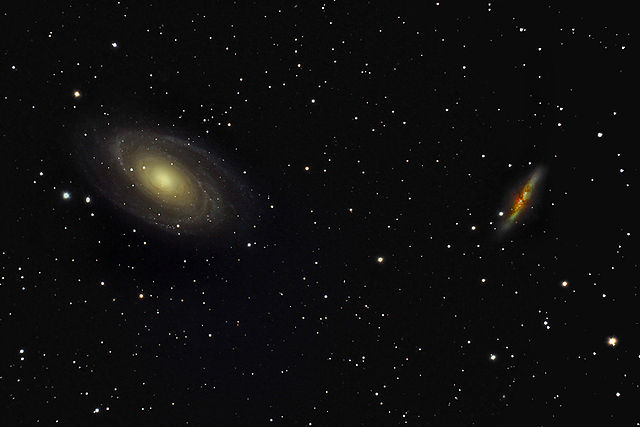Messier 81
galaxy in the constellation Ursa Major From Wikipedia, the free encyclopedia
Remove ads
Messier 81 (also known as NGC 3031 or Bode's Galaxy) is a spiral galaxy. It is in the constellation Ursa Major. It is large. It is about 12 million light-years from Earth. It has an active galactic nucleus (which has a supermassive black hole). For these reasons Messier 81 has been well studied by professional astronomers. The galaxy is large and very bright. This makes it a popular object for amateur astronomers to look at.[1]

Messier 81 was discovered by Johann Elert Bode in 1774.[2] The galaxy is sometimes called "Bode's Galaxy". In 1779, Pierre Méchain and Charles Messier reidentified Bode's object. They listed it as Messier 81 in the Messier Catalogue.[2]
M81 is dusty. Interstellar dust is found in the galaxy's spiral arms. It is connected with star formation areas.[3][4] The hot blue stars in star formation areas heat the dust and the hot dust emits infrared energy from these areas.
Remove ads
Supernova
Only one supernova has been seen in Messier 81.[5] The supernova is named SN 1993J. It was discovered on 28 March 1993 by F. Garcia in Spain.[6] At the time, it was the second brightest supernova seen in the 20th century.[7]
M81 Group

Messier 81 is the largest galaxy in the M81 Group. The M81 Group is a group of 34 galaxies in the constellation Ursa Major.[8] This Group and the Local Group, containing the Milky Way,[8] are close together in the Virgo Supercluster.
Remove ads
Amateur astronomy
Messier 81 is about 10° northwest of Alpha Ursae Majoris.[1][9] Messier 81 and Messier 82 can both be easily seen using binoculars and small telescopes.[1]
Related pages
References
Other websites
Wikiwand - on
Seamless Wikipedia browsing. On steroids.
Remove ads
